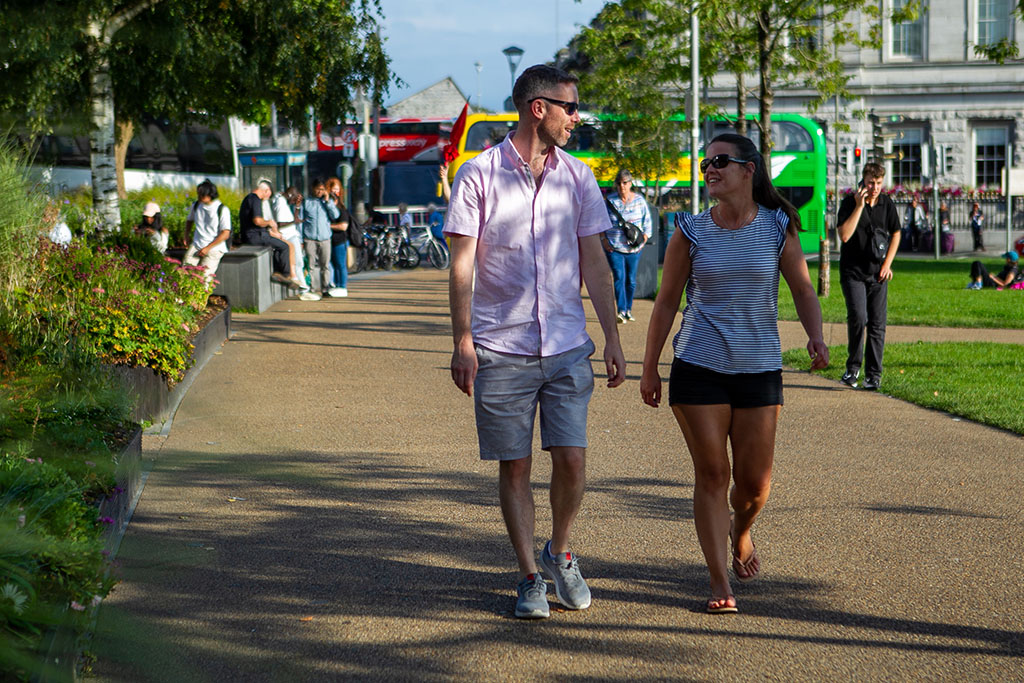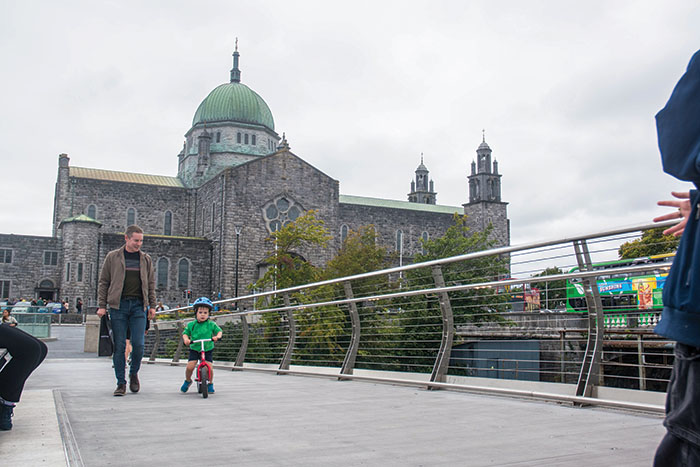6 in 10 adults in Galway Metropolitan Area walk or wheel at least five times a week, 1 in 5 cycle at least once a week
The National Transport Authority has today published the findings of the first-ever survey of walking, wheeling and cycling in Galway Metropolitan Area, which reveals that 6 in 10 (60%) of residents walk or wheel (meaning the use of a wheelchair or mobility scooter) at least five times a week, while 1 in 5 (20%) residents cycle at least once a week.
The Walking and Cycling Index provides the largest-ever assessment of walking, wheeling and cycling in Ireland. Delivered in collaboration with the Galway City and County Councils, the National Transport Authority and sustainable transport charity Sustrans, the Index was expanded last year to include Galway alongside Cork, Limerick/Shannon, Dublin and Waterford Metropolitan Areas. 18 city regions in the UK also produce reports.
The Galway Metropolitan Area Walking and Cycling Index is based on an independent demographically representative survey of more than 1,100 residents from across Galway Metropolitan Area, aged 16 and above, not just those who walk, wheel or cycle. The Metropolitan Area covers the area from Oranmore to Barna and north to Claregalway
It reveals that 77% of residents are in favour of additional investment in cycling infrastructure and 72% are in favour of additional investment in walking and wheeling infrastructure. This comes amid a growing demand for active travel with 53% expressing their desire to walk, wheel more in the future, and 42% expressing a desire to cycle more.
Key findings
Key findings from the 2023 Galway Metropolitan Area Walking and Cycling Index:
- 60% of adult residents walk 5 or more days a week, 55% use car 5 or more days a week.
- 1 in 5 (20%) adults cycle at least once a week.
- 88% of residents support building cycle tracks physically separated from traffic and pedestrians even where that means less room for other traffic.
- Every day those who walk and cycle takes nearly 29,000 cars off the road in the Galway Metropolitan Area. If all of these cars were in a traffic jam it would tail back 138 kilometres equivalent to the distance from Eyre Square to Sligo Town.
- Residents walking, wheeling and cycling create an annual economic benefit for individuals and the Galway Metropolitan Area of €144.4 million.
- Walking, wheeling and cycling improve public health in the Galway Metropolitan Area, preventing 236 long term serious health conditions annually and saving the HSE €3.55million equivalent to the cost of over 65,100 GP appointments.
- Those walking, wheeling and cycling instead of driving, save greenhouse gas emissions equivalent to 70,000 flights from Shannon Airport to London Heathrow Airport.
- There is a €1.43 net economic benefit for each km cycled instead of driven and €0.97 net economic benefit for each km walked instead of driven.
Environmental Benefits
Every day nearly 29,000 return walking, wheeling and cycling trips are made daily in the Galway Metropolitan Area by residents that could have used a car. If these cars were all in a traffic jam, it would tail back 138 kilometres equivalent to the distance from Eyre Square to Sligo Town.
The report also found that walking, wheeling and cycling save 6,300 tonnes of greenhouse gas emissions in Galway each year, which is equivalent to about 70,000 residents taking flights from Shannon Airport to London Heathrow Airport.
Health Benefits and Inclusivity
The benefits of walking, wheeling and cycling to the Galway Metropolitan Area are outlined in the report, with the physical activity benefits preventing 236 long-term serious health conditions annually, valued at approx. €3.55million equivalent to the cost of over 65,100 GP appointments.
The Index showed that residents’ travel choices and their perceptions of walking, wheeling, and cycling vary between different groups. It found that 41% of residents with a disability walk or wheel at least five days a week in Galway, compared to 62% of residents without a disability. 11% of residents with a disability cycle at least once a week compared to 21% without. While 64% of women and 57% of men walk or wheel at least five days a week, there is a larger gender gap when it comes to cycling 25% of men cycle at least once a week, compared with 15% of women.
What Residents Say Will Help Them Walk or Cycle More
When asked what would help them walk or wheel more, Galway Metropolitan Area residents want better footpath surfaces including dropped kerbs at crossing points, nicer places along streets to stop and rest and wider footpaths. When asked what would help them cycle more, residents want infrastructural improvements such as traffic-free paths through parks or greenways, signed cycle routes along quieter streets, and cycle tracks along roads physically separated from traffic and pedestrians.
There is evidence too that residents support the development of more protected cycle infrastructure within the Galway Metropolitan Area, with 88% of residents supporting building more cycle tracks physically separated from traffic and pedestrians, even where that means less room for other traffic.
Creating a Better Place to Live
Galway residents also recognise the importance of liveable neighbourhoods. 78% agree that increasing space for residents socialising, walking, wheeling and cycling on their local main street would improve their local area. 87% of residents support creating low traffic neighbourhoods where groups of streets, bordered by main roads, have ‘through’ motor vehicle traffic greatly reduced. 84% support the creation of 20-minute neighbourhoods – neighbourhoods where it is easy for people to meet most of their everyday needs in 20 minute return walk.
Economic Benefits of Active Travel
The report also found that walking, wheeling and cycling create an annual economic benefit for individuals and the Galway Metropolitan Area of €144.4m. This includes €1.43 of a net economic benefit for each km cycled instead of driven and €0.97 benefit of each km walked instead of driven. These costs were determined through an analysis of travel time, vehicle operating costs, health benefits, air quality and taxation.
Speaking on the Walking and Cycling Index, Cllr Eddie Hoare, Mayor of Galway City Council said: As Mayor of the City of Galway, I am pleased to welcome the first Galway Metropolitan Area Walking and Cycling Index. This report captures the attitudes and habits of our residents as they walk and cycle through our city. It highlights the important role of active travel for the future of Galway, benefitting air quality, health and the wider environment while complementing efforts to revive streets and to create vibrant communities. In recent years, supported by the National Transport Authority, European Regional Development Fund, and Urban Regeneration and Development Fund, Galway City Council has committed to significant walking and cycling improvements. Examples include the Salmon Weir Pedestrian and Cycle Bridge; new walking and cycling infrastructure at Eglinton Canal, Miller’s Lane and the establishment of Ireland’s first city-centre School Street at Scoil Iognáid, Raleigh Row.
“It is encouraging to see that 60% of residents walk or wheel at least five days per week, and that 53% wish to do this more in the future.
“This report comes at an exciting time, when several major schemes are ongoing, including the progression of public transport corridors on Dublin Road and the Cross-City Link. These projects reflect our missions, to make Galway the best city in which to live, work, study, visit and invest through delivering services in an equal, inclusive, and sustainable manner.”
Cllr. Liam Carroll, Cathaoirleach of Galway County Council said: “Here in Galway County, we welcome the Walking and Cycling Index report, which provides a useful and demographically representative insight into the behaviours and opinions of residents living in the areas like Oranmore, Claregalway and Barna towards walking, wheeling and cycling.
“We in Galway County Council, supported by the National Transport Authority, have started work on some exciting new projects across the area. For example, the design and delivery of a coastal cycleway which will directly link Oranmore Village to the Train Station. Another project is the introduction of a Safe Routes to School scheme in the Oranmore Village schools’ area which will facilitate safer walking and cycling for hundreds of students. We look forward to seeing how the Index supports and informs our upcoming and future projects.”
Anne Graham, CEO of the NTA said: “We’re delighted to roll out the largest survey into walking, wheeling and cycling in Ireland. Over the past few years, the NTA has been working with local authorities across the country, including Galway, to deliver safe pedestrian and cycle infrastructure that encourages more people to engage in active travel.
“It’s clear from the latest Index that more people in Galway want to cycle and walk each day. By encouraging people to make active travel a part of their daily journey, we can all play our part in creating a more sustainable future. The NTA will continue to accelerate our efforts to roll out walking and cycling infrastructure in Galway and other cities across Ireland.”
The Galway Metropolitan Area Walking and Cycling Index can be accessed here.

